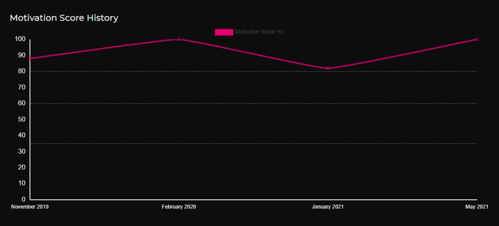How do I measure Employee Experience?
In short, we suggest that you focus your Employee Experience (EX) measurement efforts in two ways:
- Improvements in mojo maps scores (utilising our motivation platform: mojo)
- Improvements in satisfaction of moments that matter
Our ROI model is based on motivation, so it makes sense for this to be the most important measure. If you map employees before you begin any EX work, then you will have your baseline. As the EX improves, we would expect to see a rise in motivation levels. Which will improve productivity.
Of course, you need to start your EX improvement efforts somewhere and you’ll want to track how this is going. Fortunately, you can slice and dice your mojo mapping scores, so for example you could, over time, track the motivation of new starters.

If you have different job roles in your organisation, then you should compare these in distinct groups too. Nurses in the NHS would have a rather different onboarding journey than someone working on the NHS IT Helpdesk, so it would be useful to know how each group feels. The mojo Team Map allows us to create these distinct groupings.
As you will have carefully crafted a range of moments that matter, it makes sense to measure these too. We suggest surveying people who would have been a recipient of these moments, (e.g. if you have worked to improve your employees’ first day, then ask those who have recently had their first day) using the following three questions:
- How satisfied were you with X, Y, Z? (out of 10, or a scale of 0-100%)
- Why did you give this score? (free text)
- What could have been done better? (free text)
This way, you obtain a firm metric which can be tracked over time, and you receive the gift of feedback to enable further enhancements. Again, it’s sensible to bucket this by job roles, although you should have an overall score too.
Eventually, you will end up with a chart like on the one below, where you have your important Employee Journey points defined and measured on an ongoing basis.

It may be that you are already measuring aspects of your EX, so it won’t do any harm to continue with this, as you already have baseline data. But we strongly recommend focusing your measurement efforts on motivation scores and improvements to your defined moments that matter.
If organisations invest properly in EX, we would expect to see:
- Increases in Employee Engagement
- Increases in Employee Productivity
- Increases in Employee Performance
- Increases in Employee Motivation
- Increases in Employee Wellbeing
- Increases in Customer Satisfaction
- Fewer barriers to joining the organisation
- Healthier Talent Retention
- Other Employee Experience measures could include:
- Employee Survey scores
- Absence reasoning (fewer sick days lost to stress etc.)
- Turnover reasoning (fewer employees leaving due to a perceived poor culture etc.)
- Productivity gains
- Glassdoor ratings
- Customer satisfaction
- Seeing people smile more
If you’d like to understand more about Employee Experience measurement, then do get in touch.
For more on Employee Experience frameworks, view this page.


